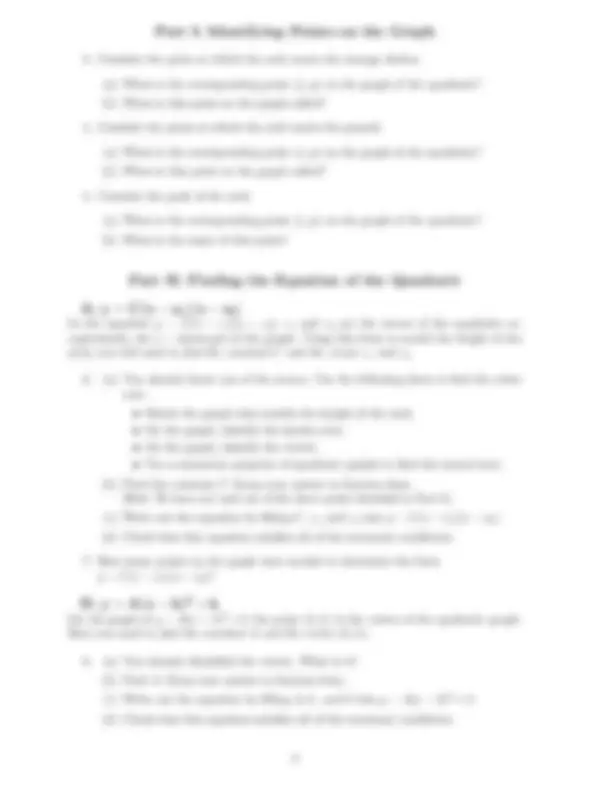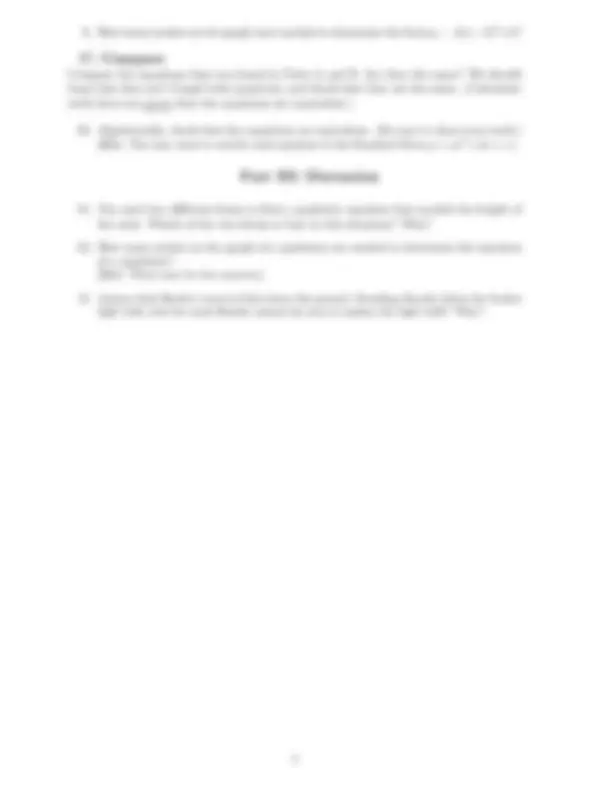





Study with the several resources on Docsity

Earn points by helping other students or get them with a premium plan


Prepare for your exams
Study with the several resources on Docsity

Earn points to download
Earn points by helping other students or get them with a premium plan
Community
Ask the community for help and clear up your study doubts
Discover the best universities in your country according to Docsity users
Free resources
Download our free guides on studying techniques, anxiety management strategies, and thesis advice from Docsity tutors
A lab exercise from a university mathematics course focused on quadratic equations. Students are required to find the equation of a quadratic based on given points on its graph. Instructions, examples, and exercises to help students understand how to identify the form of the quadratic equation (standard, factored, or vertex) based on the information provided and how to find the constants and zeroes. The lab exercise is due on april 12 and is worth noting as it will be covered in the first midterm exam.
Typology: Lab Reports
1 / 7

This page cannot be seen from the preview
Don't miss anything!




Math 148 Lab 2 Quadratic Equations Due: Wednesday, April 12
Directions: Work out each problem in the space provided on the answer sheet and write your answer clearly on the answer line. Submit the answer sheet to your recitation instructor. Material from this lab will appear on the first midterm.
Purpose: If you know two, three, four, etc. points on the graph of a line, you can determine the equation of the line. But, one point is not enough! You need at least two points to determine the equation of the line. How many points on the graph of a quadratic are needed to determine the equation of the quadratic? There are different forms of the equation of a line. You should be familiar with the following two forms:
Depending on the information provided, one form is a better choice than the others. For the equation of a quadratic, you also have a choice of different forms. In this lab you will work with the following forms:
Warm Up Exercises:
Example Suppose the point (2, 15 ) lies on the graph of y = ax^2 + 6 x + 13 where a is an
unknown constant. Find a.
Solution: Because the point (2, 15 ) is on the graph of y = ax^2 + 6 x + 13 , the point (2, 15 ) satisfies the equation y = ax^2 + 6 x + 13. That is, when x = 2 , y = 15. So, plug x = 2 and y = 15 into y = ax^2 + 6 x + 13 , and then solve for a :
15 = a(2)^2 + 6 (2) + 13 15 = 4 a + 25 − 10 = 4 a − 2. 5 = a or a = -2.
Now you try:
Situation: Having left the life of bending girders behind, Bender, the robot, finds himself performing menial tasks for Planet Express. Because Bender has the ability to extend and twist his arms, he is in charge of replacing light bulbs. Planet Expresses’ entrance is in the shape of an arch. The arch meets the top of a storage shelter 12 feet above the ground, and the arch touches the ground 27 feet away from the bottom right corner of the storage shelter. Furthermore, if you walk 9 feet away from the shelter you will be directly under the peak of the arch which is 16 feet high. The arch is lined with light bulbs. The light bulb above a point on the ground 13. feet from the bottom right corner of the shelter is broken. The last time Bender replaced a light bulb, he over-extended his arm and got his hand stuck in the light socket. (It wasn’t a pretty sight.) So his boss, Professor Farnsworth, would like to calculate the height of the broken light bulb. As Professor Farnsworth often falls asleep in the middle of his work, you have been hired to assist him. It is your job to find a quadratic equation where y represents the height of the arch above a point on the ground x-feet away from the bottom right corner of the storage shelter. You will use the equation to find the height of the light bulb that needs replacement.
arch
storage shelter
origin
ground
light
broken
y
x
Compare the equations that you found in Parts A and B. Are they the same? We should hope that they are! Graph both equations, and check that they are the same. (Calculator work does not prove that the equations are equivalent.)
Math 148 Lab 2 – Answer Sheet Page 1 of 3
Name:
Recitation Time:
a =
(b)
(b)
(b)
z 2 =
Name:
Page 3 of 3
(d) Check that the equation ...
Answer: